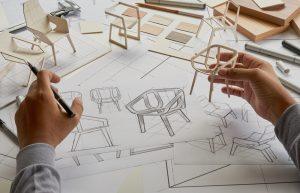When shopping for a sofa or couch, you think about its comfort, design, and whether it’ll fit in nicely with the rest of your home. You’d hardly consider the furniture’s history since there’s probably not much to it. However, that’s not quite the case.
It took the furniture industry thousands of years to get to where it is today and produce the amazing designer furniture we have available in San Diego, CA, today. In this article, we’ll describe this journey and explain the fascinating history of furniture. Read on!
How old is the oldest furniture?
The oldest piece of furniture can be traced back to a time nearly 30,000 years ago. This is when people started chipping and carving rudimentary elements from stone, wood, and bone.
Possibly the earliest reference to furniture was excavated in Russia, depicting a figurine on a throne. Other evidence includes stools and chairs in Neolithic Scotland and many other parts of the world. Although extremely rare, some instances of ancient elements, such as sofas, can be found in references that date back to ancient Mesopotamia, Rome, China, and India.
Once you take a look at the diagrams, you can see that these rudimentary stools, chairs, and beds were mostly made of wood. In ancient Rome and Egypt, people relied on veneering to improve the durability and beauty of their stools and coffins.
There’s little-to-no information to help us truly decode the manufacturing process of this ancient furniture. However, it was clearly prized since most pieces were bolstered with bronze or iron plates.
When did the furniture industry begin?
People started mass-producing furniture in the 19th century, but many important breakthroughs preceded this period. For instance, there were major changes in the functionality and style of various pieces of furniture in the 14th and 15th centuries.
People redesigned cupboards, chests, drawers, and many other elements. In addition, this is when religious institutions and wealthy households started massively adorning their abodes using finer furniture.
The 14th and 15th centuries also saw massive improvements in construction practices, leading to higher durability, value, and stronger bonds. The miter and mortise and tenon jointing processes provided stronger and more beautiful joints. They also revolutionized the process of making furniture overall. This revamped construction also gave rise to new professions, such as cabinetry.
In the 17th and 18th centuries, people’s standard of living was massively elevated. Therefore, furniture manufacturing continued to improve. Chairmaking became an esteemed profession, and since this period, it has remained a separate area of furniture production.
With an ever-greater demand for appealing furniture, the construction process became more standardized and widespread. In particular, professionals started using specific thicknesses and joints for many applications. This is where more trades separated from furniture making, such as upholstering, carving, and turnery.
As 19th-century mass production began, furniture became more available than ever. However, the manufacturing process was slow, but this changed in the next century. In the 1900s, carpenters and cabinet makers started using power tools to speed up production. Machines began to manufacture more than 100 pieces a day, which was the start of modern furniture manufacturing.
Want to make your home more elegant with stylish designer furniture in San Diego, CA? We have all you need!
It’s hard to find a reliable furniture provider in San Diego. Some companies produce low-quality items, and some have poor customer service. You won’t have this problem with D3 Home Modern Furniture.
Contact us today, and we’ll help you choose the furniture you need for your children’s room. We can also offer special items for furnishing your house if you’re a pet owner. Stop by on your way home from the Comic-Con Museum and check out our first-rate collection!








Leave A Comment